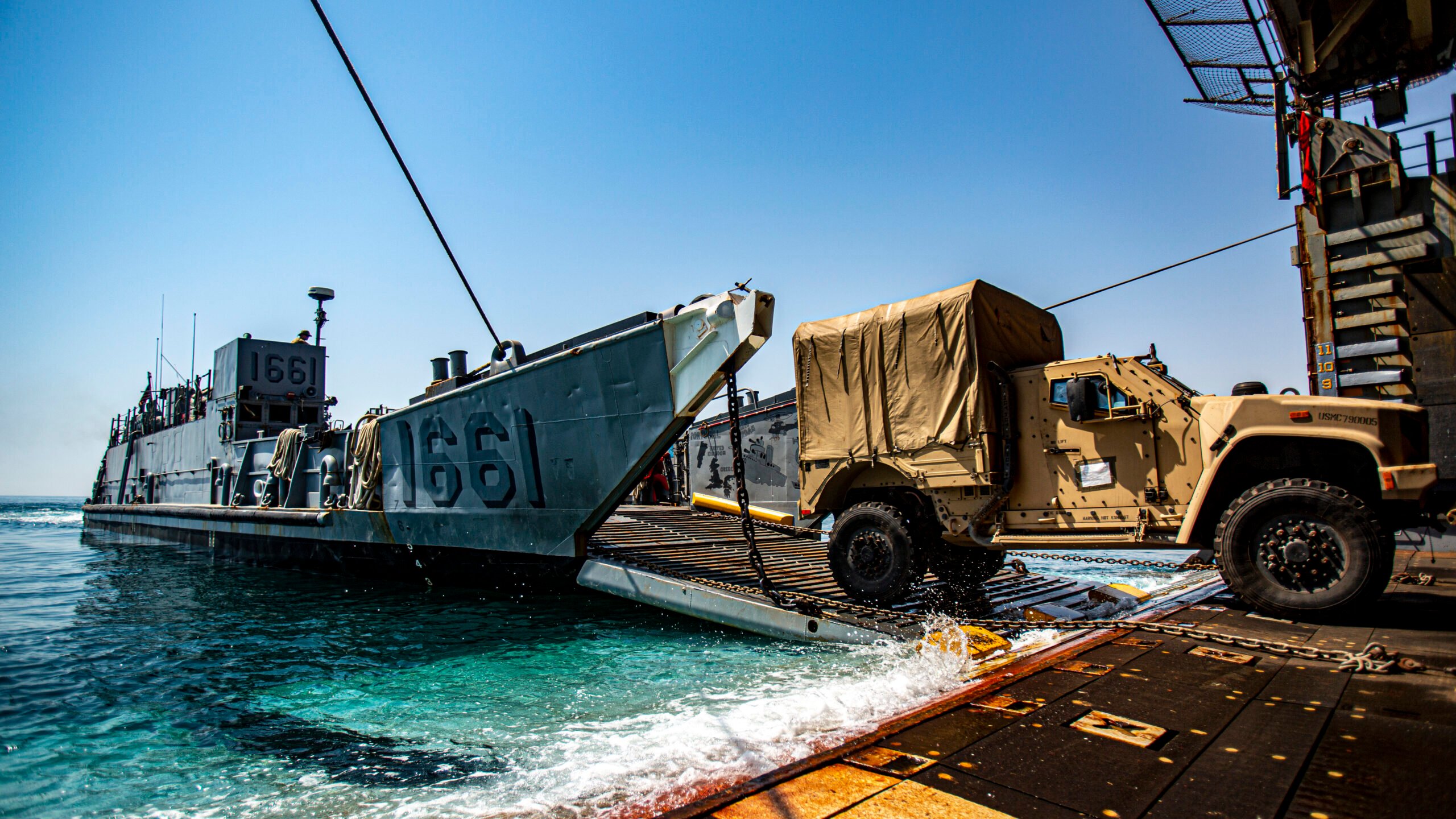
A joint light tactical vehicle attached to the 24th Marine Expeditionary Unit (MEU) is transferred from dock landing ship USS Carter Hall (LSD-50) to Landing Craft Utility 1661 during vehicle and equipment loading operations in the Arabian Gulf. (U.S. Marine Corps photo by 1st Lt. Mark Andries)
WASHINGTON — For the first time in more than a quarter century, the Marine Corps today announced a new version of one of its foundational documents guiding how it accomplishes wartime logistics, a rare update that a senior officer says drew on lessons from Ukraine and reflects both the global and contested nature of logistics Marines will face in a future fight.
“How do you reach back, where do you reach back to within that theater or that geographic region? And then in other cases, reaching all the way back to the continental United States, where we’re generating forces,” said Col. Aaron Angell, executive assistant to the service’s three-star general overseeing installations and logistics, Lt. Gen. Edward Banta. “That’s actually why we spent quite a bit of time rewriting this doctrinal publication on logistics — to explain that logistics is not just that tactical edge with that last hand off to the warfighter.”
The updated document is known as Marine Corps Doctrinal Publication 4 Logistics. An MCDP, of which there are several covering different disciplines, exists to provide the “fundamental principles” and “institutional thinking” of how the service functions. In other words, they strike at the very core of how the Marine Corps does its job. They are re-assessed for accuracy once every 10 years, and this specific MCDP hasn’t been revised since 1997, according to Marine Corps spokesman Maj. Jim Stenger.
Angell said the time gap reflects the nature of the document and its purpose, what he called giving Marines a “timeless foundational understanding” of logistics. He also said most other MCDPs have not been updated since their initial introduction including “MCDP 1 Warfighting.”
Among the new lessons, Angell said the document’s revisions acknowledge that the service’s “supply chains” may be easily broken if a single vendor is lost.
“Instead of just having a very efficient supply chain, where it’s reaching back to that one partner who’s building that one part, it’s the recognition that we need to be more resilient and understand what happens if we lose that one [vendor], if we lose that one particular logistics or resupply convoy or node,” he told reporters on Monday.
Angell also cited the “information age” and the availability of big data as driving the service’s need to update its doctrine as well as the need “to expound… more on the realization that the threat to logistics is a global threat across all domains.”
“The challenges are no longer at just the tactical, local level for our units at the forward edge. The challenge is all the way back to the United States,” he continued.
The document also cites Russia’s widely reported issues with logistics during its first year at war in Ukraine, calling the vignette “an example of the importance of logistics leadership.” That section discusses how Russia uses top-down command directives, lacks non-commissioned officers who can act independently and as a whole the military mostly lacks professional logisticians to help guide operations.
“The inadequacy of Russia’s military logistics system has consequently been a major factor in its ability to achieve its war aims,” according to the document.
The update to one of the Marine Corps’ guiding publications comes just weeks after Commandant Gen. David Berger released “Installations and Logistics 2030,” [PDF] one step in a series of reviews and overhauls the service is conducting as part of Force Design 2030.
That document largely concluded the service’s old way of doing logistics was out of sync with the distributed, future operations it envisions as part of the Stand-In Forces concept.
“Currently, our logistical capabilities are under-resourced and do not meet the demands of our future force to succeed on future battlefields,” according to the Installation and Logistics 2030 document.
Senate passes $95 billion foreign aid bill, as DoD eyes next Ukraine weapons package
Additional aid for Ukraine could be made available “within days” said Pentagon Press Secretary Maj. Gen. Pat Ryder earlier today.


























